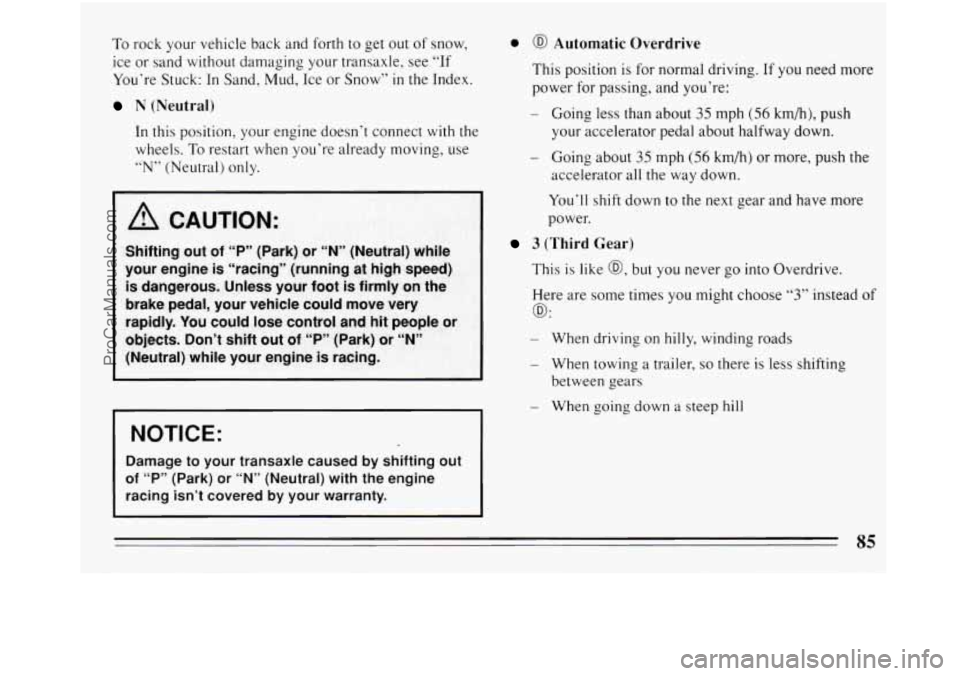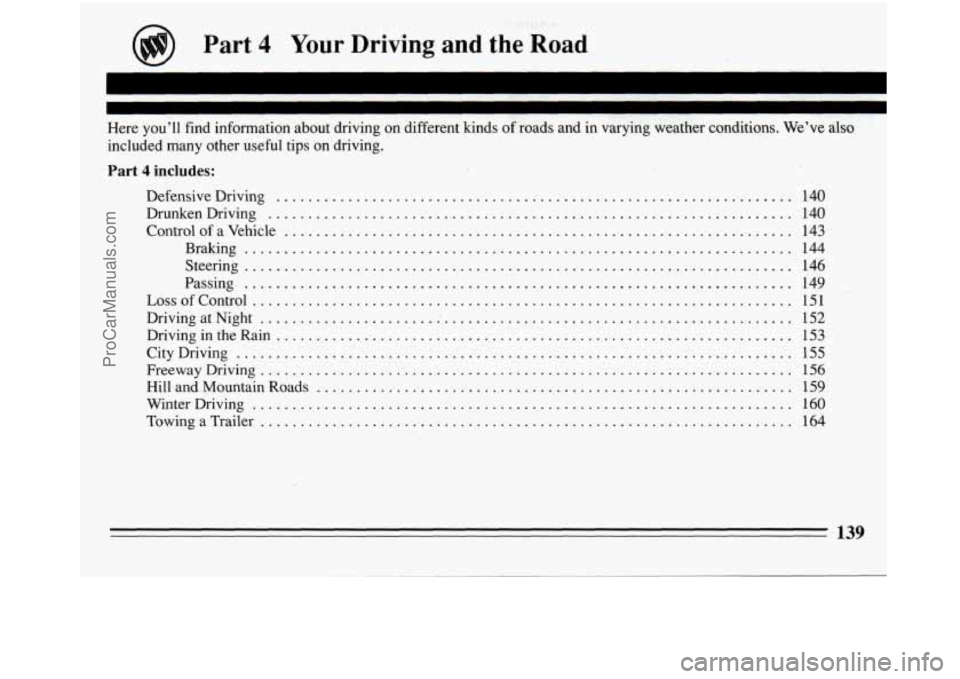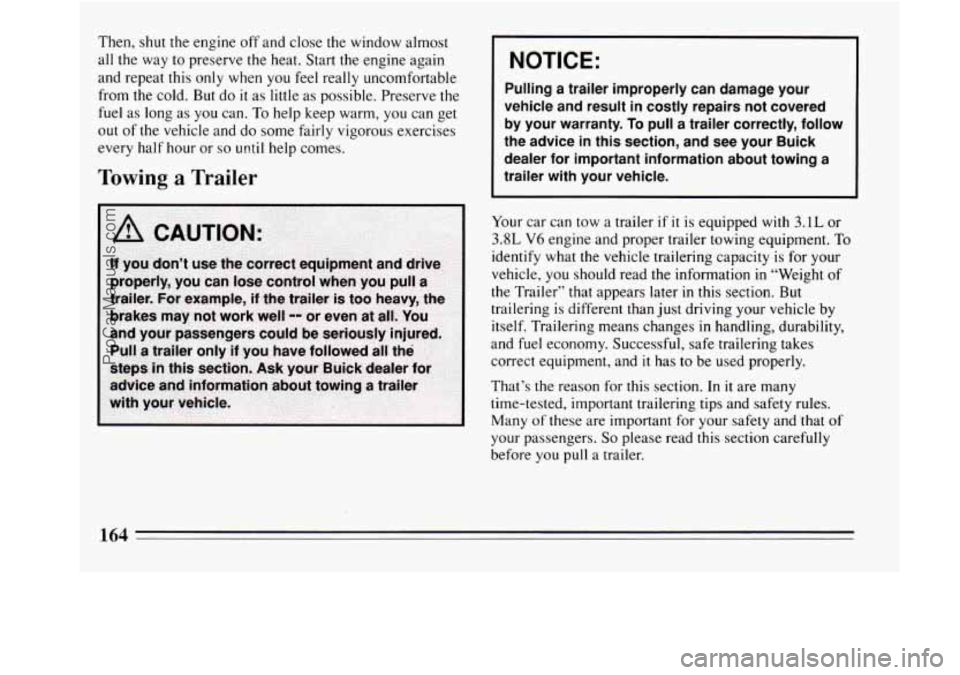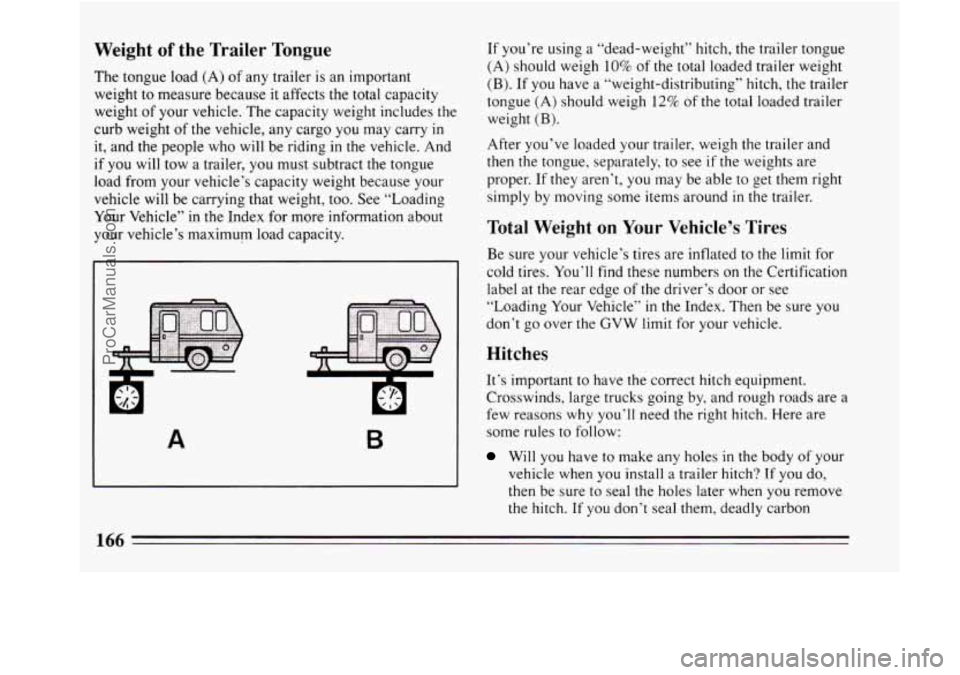1994 BUICK REGAL trailer
[x] Cancel search: trailerPage 87 of 308

To rock your vehicle back and forth to get out of snow,
ice or sand without damaging your transaxle, see “If
You’re Stuck:
In Sand, Mud, Ice or Snow” in the Index.
N (Neutral)
In this position, your engine doesn’t connect with the
wheels.
To restart when you’re already moving, use
“N” (Neutral) only.
I 6% CAUTION:
NOTICE:
Damage to your transaxle caused by shifting out
of “P” (Park) or “N” (Neutral) with the engine
racing isn’t covered by your warranty.
0 @ Automatic Overdrive
This position is for normal driving. If you need more
power for passing, and you’re:
- Going less than about 35 mph (56 km/h), push
your accelerator pedal about halfway down.
- Going about 35 mph (56 km/h) or more, push the
accelerator all the way down.
You’ll shift down to the next gear and have more
power.
3 (Third Gear)
This is like @, but you never go into Overdrive.
Here are some times you might choose
“3” instead of
@:
- When driving on hilly, winding roads
- When towing a trailer, so there is less shifting
between gears
- When going down a steep hill
85
ProCarManuals.com
Page 89 of 308

Parking Brake
To set the parking brake:
Hold the regular brake
pedal
down with your right
foot. Push down
the
paiking brake pedal with yourleft foot.
If the
ignition is on, the brake
system warning light will
come on.
The parking brake uses the brakes on the rear wheels.
To release the parking brake:
This vehicle has a push to release park brake pedal.
Hold
the regular brake pedal down and push the parking
brake pedal with your left foot. This will unlock the
pedal. When you lift your left foot, the park brake pedal
will follow it to the released position.
I NOTICE: 1
Driving with the parking brake on can cause your
rear brakes to overheat. You may have to replace
them, and you could also damage other parts of
your vehicle.
If you are towing a trailer and are parking on any
hill:
See “ Towing a Trailer” in the Index. That section
shows what to do first to keep the trailer from moving.
87
ProCarManuals.com
Page 94 of 308

Follow the proper steps to be sure your vehicle won’t
move. See “Shifting Into
‘P’ (Park)” in the Index.
If you are parking on a hill and if you’re pulling a
trailer, also see “Towing a Trailer” in the Index.
Power Windows
The controls are near each window.
92
ProCarManuals.com
Page 141 of 308

....
Part 4 Your Driving and the Road
I
. I
Here you’ll find information about driving on different kinds ot roads and in varying weather conditions . We’ve also
included many other useful tips
on driving .
Part 4 includes:
DefensiveDriving .................................................................
ControlofaVehicle ................................................................
Braking .....................................................................
Steering .....................................................................
Passing .....................................................................
LossofControl ....................................................................
DrivingatNight ...................................................................
DrivingintheRain .................................................................
CityDriving ......................................................................
FreewayDriving ....................................................................
HillandMountainRoads ............................................................
WinterDriving ....................................................................
DrunkenDriving ..................................................................
TowingaTrailer ...................................................................
140
140
143
144
146
149 151
152
153 155
156
159
160
164
139
ProCarManuals.com
Page 166 of 308

Then, shut the engine off and close the window almost
all the way
to preserve the heat. Start the engine again
and repeat this only when you
feel really uncomfortable
from the cold. But do
it as little as possible. Preserve the
fuel as long as you can.
To help keep warm, you can get
out of the vehicle and do some fairly vigorous exercises
every half hour or
so until help comes.
Towing a Trailer
I NOTICE: I
Pulling a trailer improperly can damage your
vehicle and result in costly repairs not covered
by your warranty.
To pull a trailer correctly, follow
the advice in this section, and see your Buick
dealer for important information about towing a
trailer with your vehicle.
Your car can tow a trailer if it is equipped with 3.1L or
3.8L V6 engine and proper trailer towing equipment. To
identify what the vehicle trailering capacity is for your
vehicle, you should read the information
in “Weight of
the Trailer” that appears later in this section. But
trailering is different than just driving your vehicle by
itself. Trailering means changes in handling, durability,
and fuel economy. Successful, safe trailering takes
correct equipment, and it has to be used properly.
That’s the reason for this section. In it are many
time-tested, important trailering tips and safety rules.
Many of these are important for your safety and ‘that of
your passengers.
So please read this section carefullv
before
you pull a trailer.
164
ProCarManuals.com
Page 167 of 308

Load-pulling components such as the engine, transaxle,
wheel assemblies, and tires are forced to work harder
against the drag of the added weight. The engine
is
required to operate at relatively higher speeds and under
greater loads, generating extra heat. What’s more, the
trailer adds considerably
to wind resistance, increasing
the pulling requirements.
If You Do Decide To Pull A Trailer
If you do, here are some important points.
0 There are many different laws, incuding speed limit
restrictions, having to do
with trailering. Make sure
your rig will be legal, not only where you live but
also where you’ll be driving. A good source for this
information can be state or provincial police.
0 Consider using a sway control.
You can ask a hitch dealer about sway controls.
0 Don’t tow a trailer at all during the first 1,000 miles
(1600 km) your new vehicle is driven. Your engine,
axle or other parts could be damaged.
Then, during the first 500 miles (800 km) that you
tow a trailer, don’t drive over 50 mph (80 km/h) and
don’t make starts at
full throttle. This helps your
engine and other parts
of your vehicle wear in at the
heavier loads.
0 Obey speed limit restrictions when towing a trailer.
Don’t drive faster than the maximum posted speed
for trailers, or no more than
55 mph (90 km/h) to
save wear
on your vehicle’s parts.
Three important considerations have to do with weight:
Weight of the Trailer
How heavy can a trailer safely be?
It should never weigh more than
1,000 pounds (450 kg),
unless you have the
2,000 pound (900 kg) trailer towing
option package. But even that can be too heavy.
It depends on how you plan to use your rig. For
example, speed, altitude, road grades, outside
temperature and how much your vehicle is used to pull a
trailer are all important. And,
it can also depend on any
special equipment that you have on your vehicle.
You can ask your dealer for our trailering information or
advice, or you can write
us at Buick Motor Division,
Customer Assistance Center,
902 E. Hamilton Avenue,
Flint, MI
48550.
In Canada, write to General Motors of Canada Limited,
Customer Assistance Center,
1908 Colonel Sam Drive,
Oshawa, Ontario
L1H 8P7.
165
ProCarManuals.com
Page 168 of 308

Weight of the Trailer Tongue
The tongue load (A) of any trailer is an important
weight to measure because
it affects the total capacity
weight of your vehicle. The capacity weight includes the
curb weight of the vehicle, any cargo you may carry in
it, and the people who will be riding in the vehicle. And
if you will tow a trailer, you must subtract the tongue
load from your vehicle’s capacity weight because your
vehicle will be carrying that weight, too. See “Loading
Your Vehicle”
in the Index for more information about
your vehicle’s maximum load capacity.
A B
If you’re using a “dead-weight” hitch, the trailer tongue
(A) should weigh 10% of the total loaded trailer weight
(B). If you have a “weight-distributing” hitch, the trailer
tongue
(A) should weigh 12% of the total loaded trailer
weight
(B).
After you’ve loaded your trailer, weigh the trailer and
then the tongue, separately, to see if the weights are
proper.
If they aren’t, you may be able to get them right
simply by moving some items around in the trailer.
Total Weight on Your Vehicle’s Tires
Be sure your vehicle’s tires are inflated to the limit for
cold tires. You’ll find these numbers on the Certification
label at the rear edge of the driver’s door or see
“Loading Your Vehicle”
in the Index. Then be sure you
don’t go over the GVW limit for your vehicle.
Hitches
It’s important to have the correct hitch equipment.
Crosswinds, large trucks going by, and rough roads are a
few reasons
why you’ll need the right hitch. Here are
some rules to follow:
Will you have to make any holes in the body of your
vehicle when you install a trailer hitch? If you do,
then be sure to seal the holes later when you remove
the hitch. If you don’t seal them, deadly carbon
166
ProCarManuals.com
Page 169 of 308

monoxide (CO) from your exhaust can get into your
vehicle (see “Carbon Monoxide”
in the Index). Dirt
and water can,
too.
The bumpers on your vehicle are not intended for
hitches. Do not attach rental hitches or other
bumper-type hitches to them. Use only a
frame-mounted hitch that does not attach to the
bumper.
Safety Chains
You should always attach chains between your vehicle
and your trailer. Cross the safety chains under the
tongue of the trailer
so that the tongue will not drop to
the road
if it becomes separated from the hitch.
Instructions about safety chains may be provided by the
hitch manufacturer or by the trailer manufacturer.
Follow the manufacturer’s recommendation for
attaching safety chains. Always leave just enough slack
so you can turn with your rig. And, never allow safety
chains to drag
on the ground.
Trailer Brakes
If your trailer weighs more than 1,000 pounds (450 kg)
loaded, then
it needs its own brakes -- and they must be
adequate. Be sure to read and follow the instructions for
the trailer brakes
so you’ll be able to install, adjust and maintain
them properly. Because you have anti-lock
brakes, do not try to tap into your vehicle’s brake
system. If you do, both brake systems won’t work well,
or at all.
Driving with a Trailer
Towing a trailer requires a certain amount of experience.
Before setting out for the open road, you’ll want to get
to know your rig. Acquaint yourself with the feel of
handling and braking with the added weight
of the
trailer. And always keep
in mind that the vehicle you are
driving
is now a good deal longer and not nearly so
responsive as your vehicle is by itself.
Before you start, check the trailer hitch and platform,
,
safety chains, electrical connector, lights, tires and
mirror adjustment. If
the trailer has electric brakes, start
your vehicle and trailer moving and then apply the
trailer brake controller by hand to be sure the brakes are
working. This lets you check your electrical connection
at the same time.
During your trip, check occasionally to be sure that the
load is secure, and that the lights and any trailer brakes
are still working.
167
ProCarManuals.com